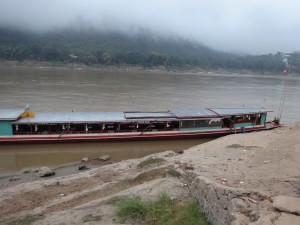 Early morning, I embark on my two-day voyage on the Mekong River. Luang Prabang is quiet, floating fog conceals hilltop temples and peaks, adding mystery and romance as our long-boat proceeds up the Mekong. Today, I will discover what makes this river ‘mighty.’
Early morning, I embark on my two-day voyage on the Mekong River. Luang Prabang is quiet, floating fog conceals hilltop temples and peaks, adding mystery and romance as our long-boat proceeds up the Mekong. Today, I will discover what makes this river ‘mighty.’
The Mekong is over 2750 miles in length, one of the longest rivers in the world. Its length and expanse also makes it one of the biggest rivers in terms of volume. Its headwaters emanate in the Himalayas of Tibet and China, borders Myanmar, Thailand, and Laos before flowing through Cambodia and Việt Nam, exiting into the South China Sea at Ho Chi Minh City. These waters provide a livelihood for thousands living along their rich shores. We travel in a long, open boat, temperatures cool but quick to warm as sun burns off the fog. Travel is slow giving time to enjoy the tranquility of the river.
Our long-boat docks at the hill tribe village of Xanghai in Pakou District situated at the mouth of the Nam Ou River. We watch the operation of a still for making traditional rice alcohol and given a taste of this 50-proof whiskey. I wonder if the snakes were alive when added to the bottles. The village Wat complex is ornate and composed of several small temples, drum house and stupas, all brightly painted and clean. Not so with the village itself where it is smoke, damp and muddy with weathered, unpainted wood buildings. However, the worst part of the walk is observing how tourism has changed village life. Each side of the path is crowded with kiosks of goods, few made locally, and women hoping you will buy. All views of the actual village and how villagers live is obstructed by endless mini-Walmarts.
We continue to Tam Ting or “Caves of a Thousand Buddhas.” High above the Mekong (even tho high waters have almost reached this aerie), several steep steps lead to a mystical cave filled with countless Buddhas of all sizes, lovingly placed amid the rocks and crannies of the cave. Tam Ting is a revered site for Buddhist and a special place to visit. Many pilgrims stay the night and it must be magical. I would have liked to leave my own little Buddha to sit above the Mekong and forever gaze into the distance.
Our last night in Lao is at a beautiful resort in Pakbeng. Our boat gently glides to the beach, we step off to the rocks and sand and after a short climb, reach magnificent sunset views over the Mekong. It is a quiet, tropical location with the sound of wildlife somewhere in the jungle behind us. The sunset upstream over the Mekong is beautiful.
The next day, our long-boat glides onto a sandy beach. We climb the dunes and enter a large K’hmu village of about 100 families. Their houses, mostly of fronds and bamboo, are elevated off the ground both for cleanliness and air circulation. Children abound, tho we are told they do go to school. It is a well-kept village with a common water source, rice storage huts, free range fowl, and pot-bellied pigs. They dry fronds along the dunes, later to be made into brooms. Another source of income appears to be millet. It is a subsistence life style and I empathize with the elderly women carrying large bags of grain to be dried. Villagers appear unaffected by our presence and have nothing to sell to the tourist. But how strange we must look walking through their village: western dress, cameras, snooping through their doors, and taking photos of their daily life.
This part of the Mekong is magical. We will spend over 20 hours on the river, giving me time to contemplate this eco system:
Lao has the lowest population density in Asia. Its mountains and plateaus make up 70% of the country; its rugged peaks range from 5000 to 9800 feet. Two-thirds of the land is forested with only 10% suitable for agriculture yet 85% is rural. Original forests of teak, illegally logged, are gone and the slow-growing second growth is highly valued and protected (tho still illegally logged).
Lao has one of the most pristine ecologies in Southeast Asia.
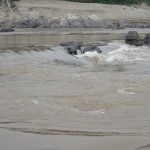 T
T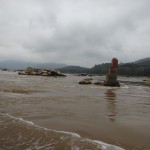 he Mekong has a varied range of depths depending upon time of year and the given area. I am told this section ranges from 12 – 30 ft. with a width from about 100 to 500 ft. The water seems calm until one sees the rocks and the current rushing past. Currents and eddies are indications of rocks beneath the surface and at times during the dry season the water is so low some areas are impassable. A boat or swimmer would be lost if slammed into the rocks. Our driver, with his Fresno State sweatshirt, gives a wide berth around these areas.
he Mekong has a varied range of depths depending upon time of year and the given area. I am told this section ranges from 12 – 30 ft. with a width from about 100 to 500 ft. The water seems calm until one sees the rocks and the current rushing past. Currents and eddies are indications of rocks beneath the surface and at times during the dry season the water is so low some areas are impassable. A boat or swimmer would be lost if slammed into the rocks. Our driver, with his Fresno State sweatshirt, gives a wide berth around these areas.
Brown waters indicate silt carried in river currents. There is little drifting garbage or pollution, but this does worsen nearer the Thailand border, perhaps because of all the construction happening there.
Along the river’s shores are isolated villages, gardens, plantations of teak and banana trees, water buffalo used mostly for meat, goats, and some commerce for grain and logging. A new road has been built and provides a second access and I can see indications of a road along a hillside dotted with power poles and an occasional cell tower.
There is little traffic on the water except for tourists and ferries. High-speed boats whiz past with bags of produce and passengers, becoming more numerous further north closer to the Thai border.
I did not expect to see wide sandy beaches along the embankment, created in times of flood. The high water marks here are well over my head, possibly as much as 20-30 feet above the current water level.
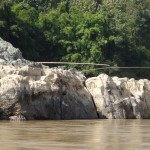 Among the rocks are fishing poles with multiple hooks. Poles, or fishing nets, are checked twice daily.
Among the rocks are fishing poles with multiple hooks. Poles, or fishing nets, are checked twice daily.
Lush tropical vegetation covers the hillsides as far as I can see: banana trees, new growth teak, tall pampas grass, corn fields, peanuts, low growing bush. Much of the growth is covered in climbing vines. Rich soil deposited by high waters regularly replenishes the soil along the Mekong.
Sporadic villages and houses on stilts can be seen in the lush growth, more villages must be out of view. Buffaloes, goats and occasional hogs forage along the shore indicating their owners can’t be far. There are a few pole fences but most animals free-range.
Where are the birds? The only birds I have seen are those in cages. No birds on the water, in the trees, or flying around. Their absence is obvious.
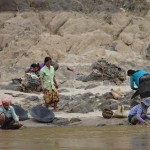 I see women washing laundry amid the rocks. Some men are panning for gold. And I watch for the elephants rumored to be used along this portion of the Mekong.
I see women washing laundry amid the rocks. Some men are panning for gold. And I watch for the elephants rumored to be used along this portion of the Mekong.
We arrive at the boundary, Lao and People’s Party flags on the right, the Thailand flag flying on the west embankment. The Mekong serves as a partial boundary for Lao, Thailand, Myanmar and China.
The change in countries and economies between Lao and Thailand is obvious as more development, better construction, soil erosion projects, and modern machinazation is seen along Thai shores.
I have slept along the Mekong in Phnom Penh Cambodia, Can Tho Việt Nam, Luang Prabang and Pakbeng Lao, and tonight Chiang Saen Thailand. I sailed its waters in Cambodia, Việt Nam, Lao, and Thailand. The “mighty Mekong” does get around.
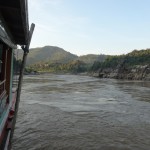 It is heavenly floating upon the Mekong, weaving among the rocks, sun and breeze caressing my face, listening to the sounds of eddies and waves slapping the rocks. But no elephants.
It is heavenly floating upon the Mekong, weaving among the rocks, sun and breeze caressing my face, listening to the sounds of eddies and waves slapping the rocks. But no elephants.
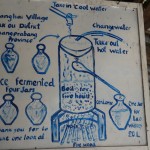
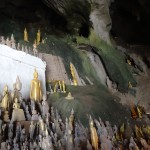
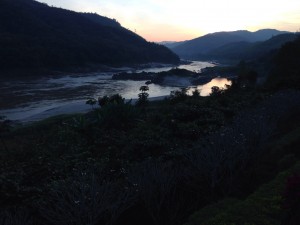
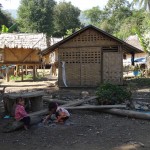
0 Comments